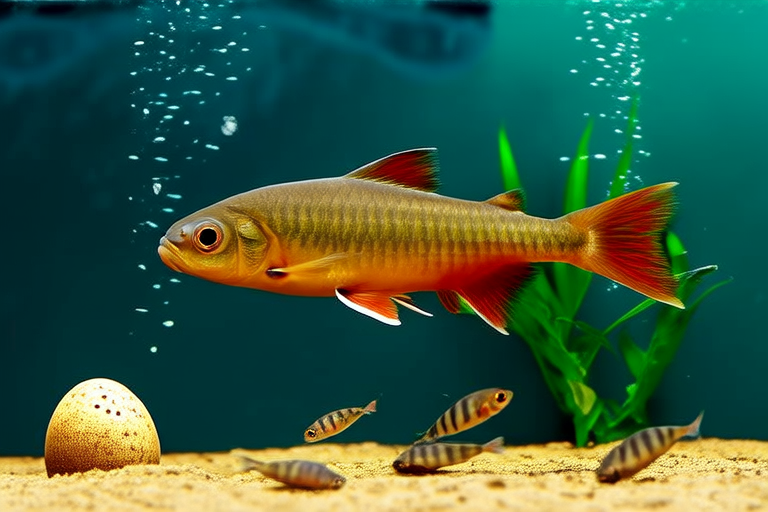From Egg to Adult: The Incredible Growth Journey of Rajah Cichlid
The Rajah Cichlid, scientifically known as Aequidens rivulatus, is a captivating species native to the rivers and streams of South America. This article delves into the lifecycle of this vibrant fish, from spawning to adulthood, covering its unique developmental stages, dietary needs, behavioral changes, and tips for setting up an ideal aquarium environment.
Spawning and Early Development
Rajah Cichlids reach sexual maturity around 12 months of age. Males display vivid colors and develop elongated fins during courtship, attracting females. Once a pair bonds, they establish a territory and begin preparing a spawning site, often cleaning a flat rock or the bottom of the tank.
After a successful mating ritual, the female lays eggs, typically numbering between 200 and 300. The male then fertilizes them externally. Both parents take turns guarding the eggs against predators and ensuring optimal water conditions. Incubation lasts approximately three days, after which the eggs hatch.
Newly hatched fry are transparent and rely on their yolk sacs for nourishment for the first few days. During this time, they remain close to the spawning site under the watchful eyes of their parents. As the yolk sac diminishes, the fry become more active, venturing further from the safety of the nest.
Juvenile Growth and Dietary Needs
Once the fry’s yolk sac is absorbed, they start searching for food. At this stage, they require small, nutritious meals rich in proteins and fats. Infusoria, a microscopic organism, serves as an excellent first food source. Gradually, their diet can be expanded to include finely ground flake foods and live foods like brine shrimp.
As juveniles grow, their dietary requirements evolve. They transition to eating larger pieces of food, including pellets designed for cichlids. Juveniles benefit from a varied diet that includes vegetables, such as blanched spinach or peas, to promote healthy digestion and growth.
Proper nutrition is crucial during this phase, as it influences their overall health and development. Ensuring a balanced diet helps prevent diseases and encourages robust physical growth. Regular feeding, but avoiding overfeeding, is essential to maintain water quality and the fish’s well-being.
Behavioral Changes and Social Dynamics
During their early life stages, Rajah Cichlids exhibit protective behavior towards their young. Parents are highly territorial, aggressively defending their fry from potential threats. This instinctual behavior decreases as the fry grow older and become more independent.
As juveniles mature, they start exploring their environment more freely, developing their own territories within the aquarium. By the time they reach adulthood, Rajah Cichlids become less aggressive towards their own kind, although they may still defend their space from intruders. Providing ample hiding spots and territories within the tank can help reduce aggression and stress among adult fish.
Dietary Needs at Each Stage
Throughout their lifecycle, Rajah Cichlids have distinct dietary needs:
- Egg Stage: No external feeding required; nutrients come from the yolk sac.
- Fry Stage: Infusoria, finely ground flake foods, and live foods like brine shrimp.
- Juvenile Stage: Small pellets, finely chopped vegetables, and live foods.
- Adult Stage: High-quality cichlid pellets, frozen foods, and occasional treats of vegetables.
Maintaining a balanced diet ensures optimal health and longevity. Regular monitoring of the fish’s condition and adjusting their diet accordingly can prevent deficiencies and promote vibrant coloration and robust health.
Tips for Aquarium Setups
Creating an appropriate environment for Rajah Cichlids is crucial for their well-being. Here are some tips for setting up their aquarium:
- Water Parameters: Maintain a pH level between 6.5 and 7.5, hardness between 5 and 15 dGH, and a temperature range of 75-82°F (24-28°C).
- Tank Size: Provide a minimum of 55 gallons for a single pair, with additional space for each additional fish.
- Hiding Spots: Offer plenty of caves, driftwood, and plants to provide shelter and reduce stress.
- Substrate: Use fine gravel or sand to mimic their natural riverbed habitat.
- Filtering System: Install a high-quality filtration system to ensure clean, oxygen-rich water.
- Decorations: Incorporate rocks and driftwood to simulate their natural environment and encourage natural behaviors.
Regular water changes and maintenance are vital to maintaining a healthy environment. Test water parameters regularly and address any issues promptly to prevent diseases and ensure the longevity of your Rajah Cichlids.
Unique Characteristics and Challenges
Rajah Cichlids possess several unique traits that make them fascinating yet challenging to raise:
- Coloration: Their vibrant hues and intricate patterns make them visually striking. Proper lighting and a balanced diet enhance their coloration.
- Aggression: While generally peaceful, they can become territorial, especially during breeding. Providing ample space and hiding spots helps mitigate this behavior.
- Parental Care: Their strong parental instincts can be both a blessing and a curse. While attentive parents protect their fry, they may also become overly aggressive, posing risks to other tank inhabitants.
- Environmental Sensitivity: Sudden changes in water parameters can stress Rajah Cichlids, leading to health issues. Gradual adjustments and regular maintenance are essential.
Understanding these traits and addressing potential challenges proactively ensures a thriving environment for Rajah Cichlids. With proper care and attention, these fish can thrive and bring joy to both novice and experienced aquarists alike.
In conclusion, the journey from egg to adult of the Rajah Cichlid is a testament to nature’s wonders. From their intricate spawning rituals to their vibrant coloration and protective instincts, these fish offer a rewarding experience for those willing to invest the time and effort. By understanding their unique needs and providing a suitable environment, you can enjoy the beauty and complexity of Rajah Cichlids in your home aquarium.
